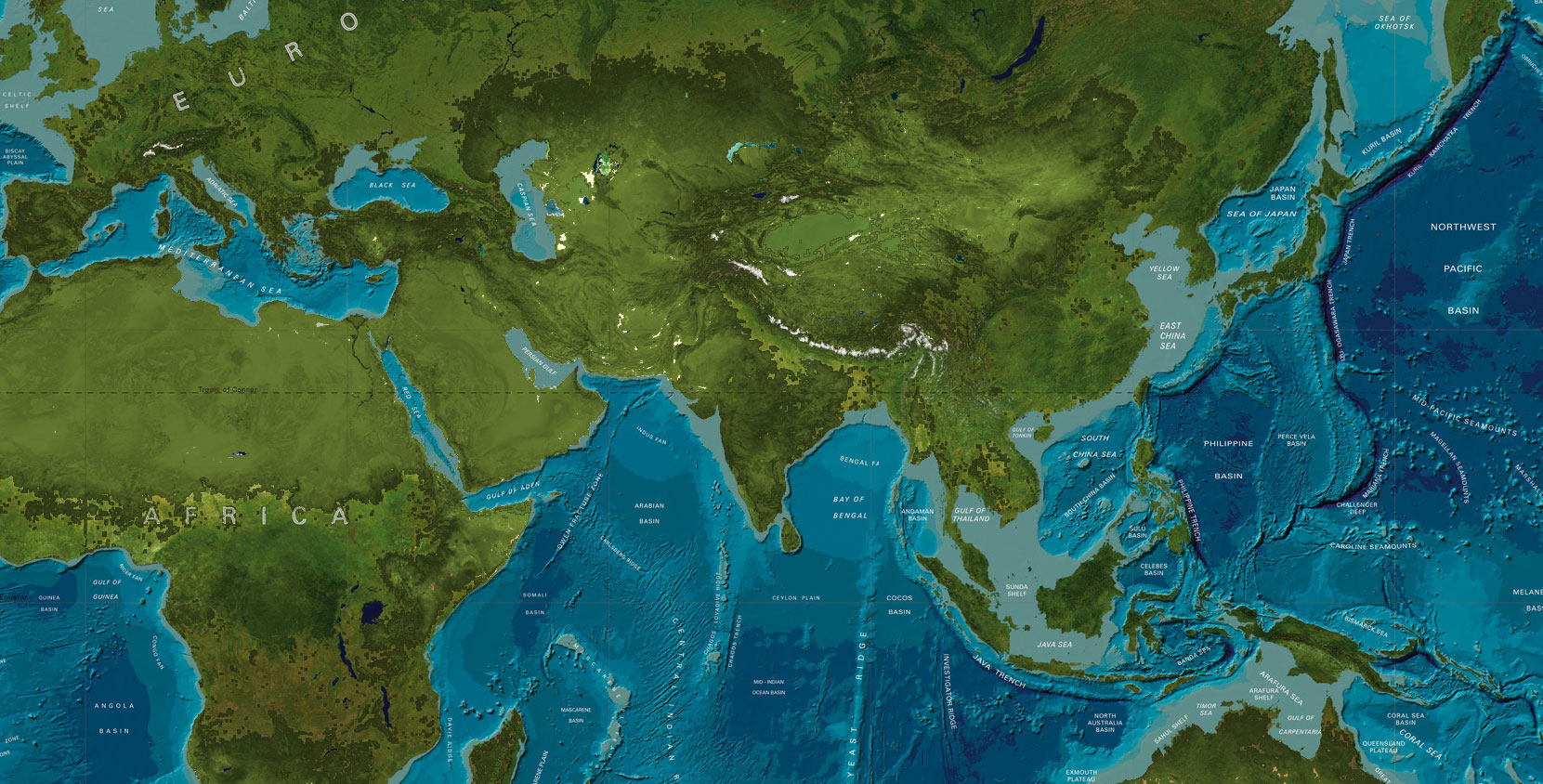
Post Ice Age Migration
Exposition One
When the Ice Age was ending, the sea level rose about three feet per year, almost all the sea level rise within a century or so, engulfing about twenty-five million square miles of coastal real estate (essentially the continental shelf) with catastrophic ‘though gradual climate change, when the Middle East, northwest India, and North Africa, turned from green to desert, as the cloudcover for the ice age was dissipating, that climatic regime never to be seen again (unless the ocean would be heated again geothermally). Beginning circa 1500 b.c. as the Ice Age started to end, the worldwide mass migrations of people groups are acknowledged by even mainstream archaeologists, when the Aryans for instance from western Asia migrated east into India, and the wandering biblical Hebrews out of Egypt taking the southern part of the mediterranean coastal mountain range in the promised Canaan land while the canaanite cities below dried up, the israeli terrace farming then taking over in the rainier highlands as the “bronze age” collapsed, the time too of the founding of Troy on the newly risen ocean coastline, that was the time of king Dardanus, namesake of the Dardanelles, the connection to the Black Sea, which had been but an inland lake during the Ice Age.

Inundated “Bronze Age” Land
Mainstream archaeologists marvel at the thousand invading ships of the Sea Peoples reported by the egyptian scribes circa 1300 b.c., wondering why the distress on those people such that they would invade mighty Egypt? And what of the ancient kingdom of Yam, trading partner of Egypt, the land of ivory and timber, now stranded in the Sahara desert, seven hundred miles west of the Nile? The climate change is actually described in the ancient egyptian Ipuwer Papyrus, secular proof that the Ice Age was ending at that time of the Exodus of the Jews, the cllmate change, plagues, and anarchy corroborating the report in the Bible, with the submerged ruins of Menouthis and Heraklion at the mouth of the extinct Canopic branch of the Nile bearing testament to that great loss to the sea when the Ice Age was ending. Does not the biblical timeline fit the evidence? Should we not take another long hard look at the carbon 14 dating method, not to mention the other radioisotope dating methods (http://globalflood.org)?

Geopgraphy AFTER Ice Age
Plato said that much of Greece was consumed by the sea too, the Flood of Ogyges, at the time of the destruction of Atlantis, that empire which he said extended both outside and inside the Pillars of Hercules, inside as far as Italy and Libya, those were the Sea Peoples who invaded Egypt shortly after the Hebrews had departed, as New Kingdom Egypt would never approach the magnificence of the Old Kingdom dynasties, which had the climatic advantage during the Ice Age, before all hell broke loose around the world when it ended, ‘though gradually, barely fast enough for them to have known what was happening to them; it must have been a very perplexing time, when such as the Amoricani (Americos) and Veneciuela (Veneti) of Brittany and the Amazons of Libya sailed west, the namesakes of the Amazon, Venezuela, and America, not to mention the atlantean Antaeus of the Andes, the Antisuyos, and those Breasils of Galway to Brazil. So they say Colombus was first to sail across the Atlantic? Does that ring true in light of all this? Does it add up considering the ancient mapping method by the earth’s wobble rate which proves they knew exactly where on earth they were to within a remarkable degree of accuracy of 0.5% (ten times the accuracy by Eratosthenes)?
Exposition Two:
When you look at the current geography of the locations now in deserts of many bronze age sites of cities and smaller settlements from the 2000 b.c. timeframe (in the Sahara, the deserts of the Middle East, and northwest India and Pakistan for instance), you’ll realize the climate changed drastically to have caused their abandonments, cities such as Jiroft in old Elam, the kingdom of Yam in Libya, Tel Leilan in Syria, and Mohenjo Daro in Pakistan, cities abandoned circa 1500 b.c.
The lead scout named Aristoboulos for the military campaign of Alexander the Great in India circa 350 b.c. reported that there were over 800 abandoned sites in the Great Indian Desert (in the shadow of the Hindu Kush mountains), those ruins of the Indus Valley Civilization, and of course, submerged offshore are the ruins of Kususthali in the Gulf of Kutch and the two big cities ninety miles from shore in a hundred feet of water in the Gulf of Chambay (named after Cham/Ham), so obviously the demise of the Indus Valley Civilization was because of the end of the ice age with its prodigous sea level rise and catastrophic climate change. Just ask Harvey Weiss at Yale.
And in the south Pacific are the submerged megalithic ruins for instance off Yonaguni (Japan) and Ponape (Caroline Islands), obviously submerged since the end of the ice age, then some of the people from those submerged kingdoms having sailed east across the Pacifiic as far as Easter Island and South America, the sophisticated ruins there from bronze and iron age times so attesting. Now then who can deny the biblical timeline and template that the ice age ended much later than we’re being told? Is there any other explanation for these submerged ruins and the catastrophic climate change evidenced by the bronze age ruins now in deserts?
Exposition Three:
Mainstream scientists, without admitting that the ice age ended circa 1500 b.c., cite almost all the natural results caused by the end of the ice age as reasons for the mass migrations of people groups from 1500 b.c. to 1000 b.c. They mention drought, famine, and political instability by overpopulation of ancient homelands. Of course the overpopulation of homelands was caused by the sea level rise and the resultant loss of coastal real estate when the ice age ended, the drought having caused famine by the drastic loss of rainfall because the cloudcover was greatly diminished as the ice age came to its end.
The “sea peoples” invaded the eastern Mediterranean while the deserts of the world were forming, vast tracts of north Africa becoming the Sahara at that time, and southern Spain changing from the lush environ of atlantean times with elephants, two harvests per year, and fruit trees abounding by natural watering, to its current state of marginal farming due to generally arid conditions. Greece transitioned from a rich land of many streams, rivers, and lakes, with huge forests and two harvests per year (noted in Plato’s Atlantis account) to its current state of relative aridity. The Sardinoi invaded coastal Egypt from diminished Sardinia circa 1200 b.c., the mycenaens of Greece attacked Troy also at that time, and the Peleset or Palaeste of the Adriatic sea, the Philistines, invaded Israel and Egypt (where the port city of Pelusium was founded), all because their land was diminished by drought and loss of real estate.
The tribe of Dan of the Israelites sailed as far as Britain when the bronze age was collapsing, known in their new home as the Tuatha de Danaan. And Aeneus fled Troy to help found the Etruscan civilization, with their pelasgian (Peleg) language, after the invasion and domination of Troy by the Mycenaens, with the carians, allies of the Trojans, after their defeat at Troy having sailed even to South America, the Caribbean sea and Carioca (now Rio de Janeiro) the carian namesakes. So how did those tribes navigate great distances across vast oceans when but such is not thought to have been possible by mainstream scientists? Those scientists of the darwinian bent won’t acknowledge that the ancients measured the earth and so could calculate distance and direction by the slow wobble rate of the earth’s axis against the backdrop of the stars of the constellations.
Rongorongo, the ancient written language of Easter Island of the remote southeast Pacific ocean, has perplexed academics because its signs bear great affinity to those of the Indus Valley written language, separated by 13,000 miles of vast ocean, both languages considered not deciphered at this time, but the indus language was in reality vedic sanskrit, semitic lettering having been applied to it to replace the original signs now found also on the easter island rongorongo written records, so the “undeciphered” Easter Island language is related to the vedic sanskrit of India, as the darwinian linguists will soon learn with help from us, friends and seekers of truth who believe the Bible as it reads, the key to solving the mysteries of the ancient world, the biblical template of Genesis 10.
See YouTube presentations at: http://youtube.com/genesisveracity
For more information on a topic of interest, use a search engine such as Google keying in the topic preceded by keying in Dancing From Genesis, for instance key in Dancing From Genesis Colombus Navigation to see blogposts on this topic.
